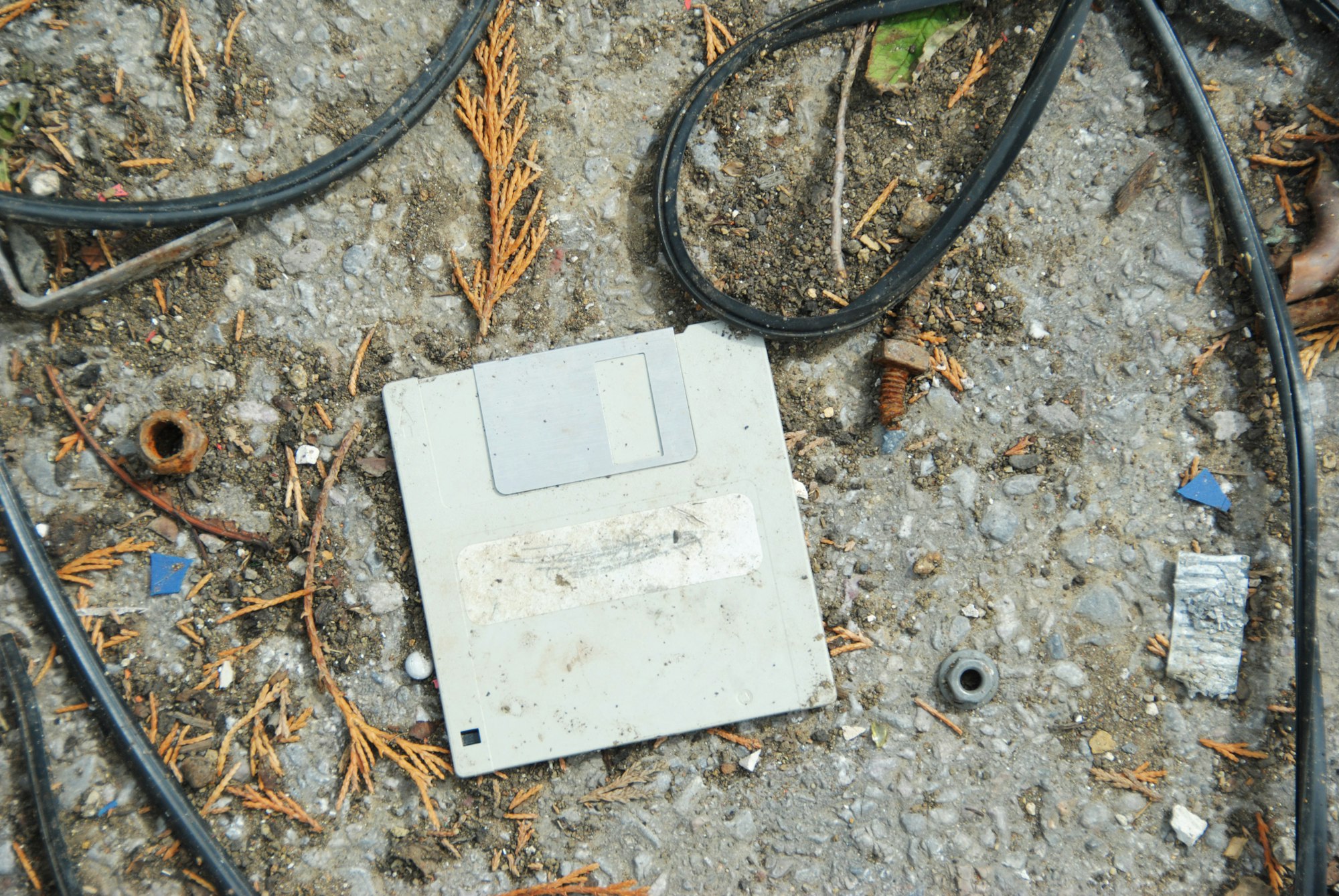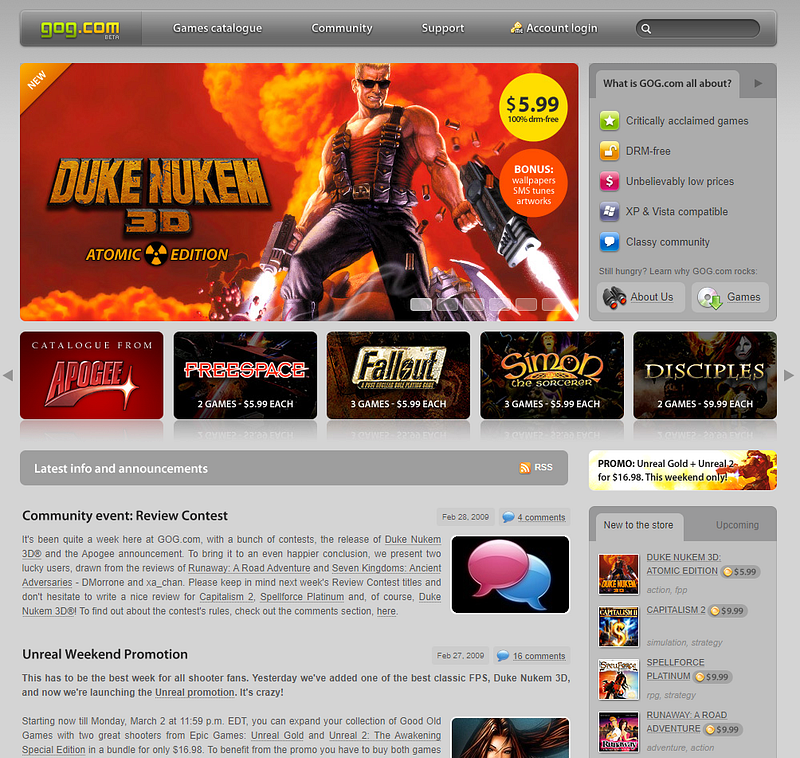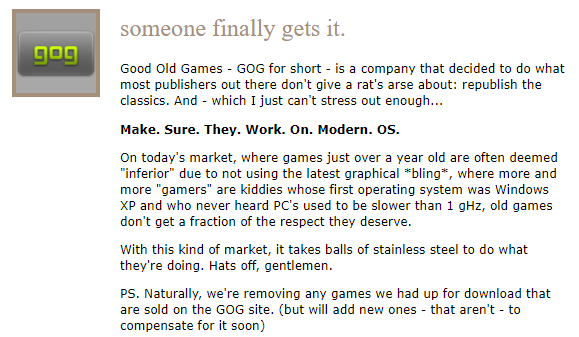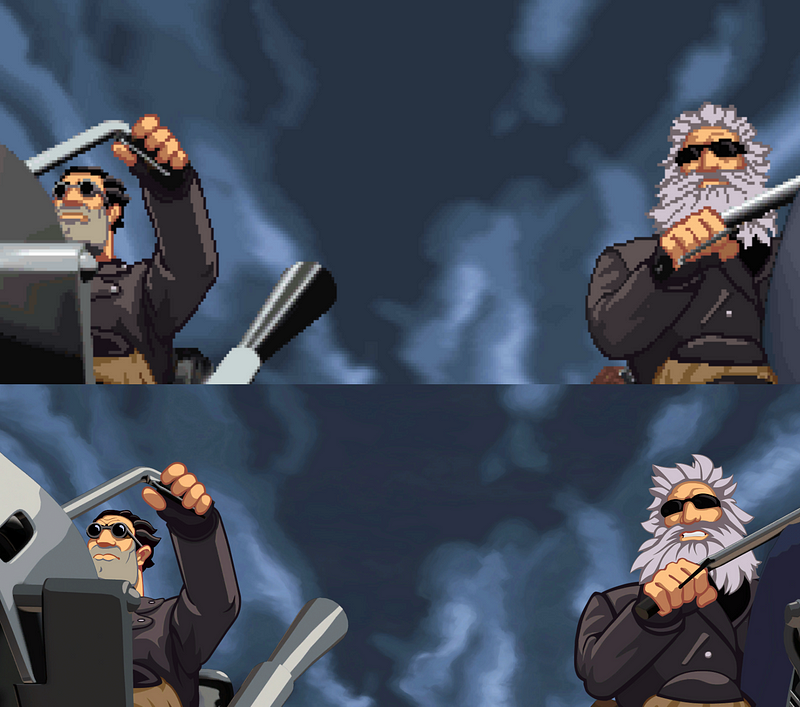The Unsung Heroes of Game Preservation, Part 2
The arrival of GOG, remasters, and the future of abandonware

In Part 1, we traced the origins of the abandonware scene and the purveyors of those games. But a delineation point was being reached in the early 2000s, as the hobby matured but struggled with how to handle aging games and aging hardware. A new solution seemed necessary, and it was about to come from an unlikely place.
Good Old Games
In 1994, Marcin Iwiński and Michał Kiciński founded the Polish software company CD Projekt. Initially, they specialised in importing and localising games for the Polish and Eastern European markets. By the early 2000s, the profitability of localisation started to wane as globalisation began to hit the games industry, and Western games were increasingly available in Eastern Europe with localisation as a standard.
In 2002, CD Projekt established a game development arm called CD Projekt RED. They acquired the rights to Poland’s most renowned fantasy fiction series, Wiedźmin (The Witcher). Utilising BioWare’s Aurora Engine (which was created for 2002’s Neverwinter Nights), CD Projekt RED eventually released The Witcher in 2007.
The Witcher received fairly good reviews and was praised for the depth and maturity of its storytelling. Most importantly, it put CD Projekt on the games industry map, launching them from an unknown Polish independent studio to an internationally regarded game developer.
Having established for themselves a strong foundation, CD Projekt turned back to their roots. By the late 2000s, digital rights management (DRM) was becoming increasingly restrictive and intrusive, an effort by studios to combat software piracy. The unfortunate side effect was that gamers who legitimately (and legally) purchased games often had to deal with DRM-related software that prevented them from using the software in the way they wished. DRM sometimes caused major performance issues (the infamous Denuvo), or would include what was essentially spyware or malware (from a security point of view, it was ironically sometimes safer to install pirated versions of games).
This went against the philosophy of Iwiński and Kiciński, who had grown up in the heady liberal days of post-Cold War Poland, where copyright laws were rarely enforced and the freedom to buy, trade, share and play games was a hallmark of the Eastern European games industry. The duo also recognised that this shift towards overly-intrusive DRM came with IP-hoarding, and classic games were increasingly difficult to acquire. So, in 2008, in response to the state of game distribution, CD Projekt launched what was then known as Good Old Games.

It’s hard to describe the pervasive sense of joy that erupted from the abandonware scene when Good Old Games launched. Finally, a site dedicated to classic games, that was offering them DRM-free, for very reasonable prices, and (usually) preconfigured with DOSBox to work on modern PCs. Every single abandonware site celebrated the appearance of GOG, and instantly began removing downloads for any game that was hosted on GOG.
Here’s a screenshot from Abandonia on 30 October 2008, shortly after the launch of GOG:

It wasn’t just the abandonware sites either — the mood in abandonware IRC channels was ecstatic as well, although I must admit they stopped shy of removing a lot of games. Of course, the real appeal of GOG was that they made some effort in ensuring modern PCs could run these old games. Abandonware downloads were usually provided “as is” while spending a few dollars on GOG (most games were no more than about $10) ensured that you could skip the hassle if you weren’t technically minded.
In September 2010, to the dismay of many, GOG announced it would be closing down. I remember speculating that maybe it had all been too good to be true and that maybe the market for classic games simply wasn’t big enough. The gaming press bemoaned the disappearance of the sole bastion of DRM-free classics, as did the abandonware scene, which was hit particularly hard by the bad news.

Thankfully, it all turned out to be a rather clever marketing ploy. A few days after shutting down, and receiving a lot of press because of it, GOG relaunched on 23 September 2010 with a new direction. They would retain their position as the gold standard for the distribution of classic games, but within a few months, they would be expanding their distribution into indie games and the AA and AAA games market.
Despite the change, they held to their core value of only providing games without DRM. It was, and still is a contentious strategy. The general idea among software publishers is that gamers are a bunch of freeloading thieves that will use any form of piracy available to avoid paying for a game. GOG took a different approach. They believed that, by offering games at a reasonable price, without DRM, they would garner goodwill in the community. They also made the rather intelligent assumption that, in most cases, gamers would only pirate a game if they couldn’t afford to buy it — so you weren’t necessarily losing money, you were merely gaining exposure.
Whether those perspectives are reflected in the data is up for debate, and to my knowledge, there has not yet been any large-scale empirical research to give an indication either way. But anecdotally, I can vouch for this approach. I always buy from and promote GOG, and I do so not because of some vague preference — it is because I strongly believe in their values, and in particular their support for classic games.
GOG’s rise was rapid and surprising. The undisputed king of the digital distribution market was, and still is, Valve’s Steam platform. But Steam’s dominance was no longer a total monopoly. Prior to the arrival of Epic Games’ distribution platform, estimates put GOG’s digital distribution market share as somewhere between 10 and 15 percent, second only to Steam and a remarkable achievement for a small outfit from Eastern Europe. Epic has since supplanted GOG thanks to their aggressive pursuit of Steam’s monopoly, but GOG has concurrently grown at a steady rate, and the last few years have seen GOG booming with several high-profile game acquisitions available nowhere else.
Kickstarter and the Retro-Revival
GOG’s meteoric rise highlighted two important facts to the games industry. Firstly, it was that Steam’s dominance was by no means assured, and with the right strategy, a platform like GOG could convert customers and inspire unflinching loyalty. The second fact had far larger consequences: the discovery that “retro equals money”.
By the early 2010s, “Retro-Revival” was starting to hit its stride. GOG was no longer the only platform for classic games, and DOSBox-enabled classics started to appear on Steam as well, then eventually also on EA’s Origin and Ubisoft’s Uplay. Remasters were still in their infancy but were gradually becoming more commonplace.
GOG wasn’t the only contributing factor to this Retro-Revival, but it seems clear that it played a significant role. Their huge initial success through the distribution of classics showed the industry that the market was ripe for classic games, but it also highlighted an important demographic that had often been ignored by the industry — older gamers. Industry associations like the Interactive Games and Entertainment Association had been producing reports for years showing that the average age of a gamer was steadily increasing, and had been comfortably sitting in the 30–40 age bracket for many years. These older gamers remembered the classics, and were often disgruntled at emerging trends and clamoured for the “good old days”.

In 2009, Beamdog was established by ex-BioWare developers Trent Oster and Cameron Tofer. They acquired the rights to BioWare’s classic late 90s Infinity Engine games, and in 2012, released Baldur’s Gate: Enhanced Edition, followed by Baldur’s Gate II: Enhanced Edition in 2013. These beloved classics rocketed back into the spotlight, giving the Retro-Revival a solid kick in the direction of classic RPGs.
The other factor in the Retro-Revival, apart from GOG, a handful of remasters, and general gamer demographics, was the indie scene. The sudden explosion of indie games from about 2012 onwards highlighted some key design trends that the AAA industry had either ignored or simply didn’t pick up on. First and foremost was an aesthetic that became synonymous with indie games — low-fidelity, pixelated graphics. Graphics in indie games were nowhere near as technically impressive as their AAA counterparts — indie developers, for the most part, simply didn’t have the resources required for creating complex game engines. So, they looked to the past and embraced the simple but effective visual communication of eras gone by.
Together with the retro aesthetic, indie developers took old gameplay mechanics and design principles and applied a modern spin to them. Fez (Polytron Corporation, 2012) took the traditional 2D platformer in a unique direction with gameplay depending on the ability to spin the game world 360 degrees. FTL: Faster Than Light (Subset Games, 2012) offered a unique combination of the roguelike and management genres. The explosion of indie games flooded the market with new ideas with a nostalgic bent, and the games that inspired this era started to attract their own attention.

It was also this time that saw the emergence of crowdfunding, predominantly through Kickstarter. Indie developers used the platform to great effect, raising funds to support their development cycle that sometimes rivaled the budgets of bigger studios. What became immediately apparent was that managing a large budget effectively was something that required a certain degree of experience and discipline, and many of these indie outfits failed to live up to expectations.
One group of developers that did have experience managing budgets like this were exactly that — career game developers. It had become clear in the 2010s that the AAA publishing industry had turned away from genres it deemed not “on trend”. If you were a game developer in 2015 looking to secure funding for an old-school, complex RPG, you probably weren’t going to get a lot of financial backing. The thing is, despite all their claims that they understood the market, publishers like EA and Ubisoft really didn’t seem to get it. Gamers wanted old school, and a lot of professional developers wanted to make them, but couldn’t secure funding. So, they took a leaf out of the indie playbook and turned to crowdfunding.
Professional game designers began to embrace crowdfunding and establish independent studios to fund AAA-quality games that embraced classic design methodology. Torment: Tides of Numenera, Pillars of Eternity, and Wasteland 2 all relied heavily on nostalgia for RPGs of eras gone by, and the crowdfunding campaigns of these classic-style CRPGs were wildly successful. But they were by no means the only genre getting the retro treatment. First-person shooters and strategy games also started to appear, in addition to the already booming platformer scene.
The sudden rise of indie and crowdfunded studios, embracing retro design principles, put the AAA industry on notice. Before long, they too were looking to the past for inspiration, and as it turned out, one of the fastest and easiest ways to make a quick dollar in this market was the "Remaster".
I like your old stuff better than your new stuff
Remasters, to this day, are a huge industry, and have come to define the modern definition of “classic gaming”. However, the remaster industry is also defined by endless controversy over matters such as design philosophy, faithfulness to the source material, removing contentious content, pricing, and preventing access to original games. These are just a few of the many reasons that abandonware scene remains relevant in 2023.
One of the most egregious examples of a poorly executed remaster was Blizzard’s attempt with Warcraft III: Reforged. This remaster made significant changes to a game that had always had an incredibly devoted fanbase, and many of those changes upset the delicate balance that defined Warcraft III multiplayer. On top of this, not only did they remove the original Warcraft III from sale, but they implemented a mandatory patch that removed features from the original game. To put this in context, this would be like a book publisher walking into your house one day, taking your favourite book off the shelf, and tearing out a few random chapters’ worth of pages.
One lot of remasters that have come to define how to “do it right” are the remasters of LucasArts adventure games. The Monkey Island series, Full Throttle, and Day of the Tentacle are all presented without any changes to core gameplay and plot, while receiving a visual upgrade in the form of refined art to bring their visual appearance up to modern standards. However, one important thing that they also include is the option to play the games with their original graphics.

Unfortunately, this is not always the case, and remasters often make significant changes to the source material. As I hinted at earlier, this is where rule three of the Abandonware Code comes into play:
3. If a game becomes available for sale, or is rereleased in its original form (this is an important point), then an abandonware site must remove the game and provide a link to the new distributor.
For various reasons, gamers who play classic games want to experience them in their original form. Some do it for nostalgia, out of a desire to play the games as they remember them. Others see games as an important part of digital history and want games to remain available in their original form for posterity’s sake. And in some cases, gamers might simply lack the required hardware that a remaster requires, as many of them have significantly increased system requirements. For me, it has always been some combination of all of these. But the one I believe is most important is game preservation.
A problem that has arisen from the remaster industry is that publishers wish to disincentivise the purchase of original games in favour of their remasters, which usually sell for significantly higher prices. In the case of Call of Duty: Modern Warfare, the cost of the original game (2007) is still around USD $20, compared with the remastered version (2017), which sells for USD $40.
Unfortunately, this is usually out of the hands of digital distributors to control. When Beamdog released their Infinity Engine remasters, they forced GOG to remove the original games from sale — something that annoyed several gamers, who didn’t appreciate the modifications made in the enhanced editions. To their credit, Beamdog eventually made the decision to bundle the original release with the remastered version, but this isn't always the case.

In recent years, the Internet Archive has played an important role in game preservation and has become a sort of de facto abandonware site. While modern abandonware sites like MyAbandonware have done an admirable job in championing the game preservation movement, the Internet Archive has lent an air of legitimacy that has elevated the reputation of the entire scene.
Another factor to consider is that remasters have limited potential for success, and generally, it is only the iconic or financially successful games that receive the remaster treatment. Yet for every successful remaster, there are hundreds of forgotten classics. The Mass Effect trilogy has received the remaster treatment in the form of Mass Effect: Legendary Edition— a mere nine years after the release of Mass Effect 3. Meanwhile, cult titles like No One Lives Forever and Rocket Jockey seem destined to be forgotten. This is why abandonware continues to play an important role in game history.
The Future of Our Past
The abandonware scene has proven immensely resilient, but despite their dedication and ingenuity, the future presents unique challenges that will be difficult to overcome. The large-scale shift to “games as a service” means that a studio can simply stop supporting a game when it is no longer financially viable — sometimes rendering them unplayable if the master server is shut down. In some cases, ingenious players have reverse-engineered software (with mixed results) to re-establish a community. This is common in the MMO scene, and until the arrival of World of Warcraft Classic, there was a thriving private server community. The same can still be said for games like Ultima Online, Star Wars Galaxies, and EverQuest.
Digital distribution continues to dominate the modern games industry, particularly for PC gaming. Yet there is a commonly held conception that once you buy a game on Steam, EA Play, or Uplay, you “own” that game. This is often not the case — you are simply paying for the right to use that software, a right that can be revoked at the publisher's or distributor's discretion. It is critical that gamers support platforms like GOG, which are committed to DRM-free releases. Even if a game is removed from their store (much like the original Baldur’s Gate release), their company policy is that this game is never removed from your account, and all games come with separate installation files independent of any launcher, so you can back these games up in your own archives, if you so wish.
Services like EA Play and Xbox Game Pass have shown that there is a huge appetite for an on-demand, subscription-based model of distribution. In the ever-changing world of software licensing, there will be the endless challenge of having to juggle subscription services just to play the games that you love. Some have suggested that on-demand gaming and cloud gaming is the way of the future, and many titles may one day only be offered in this way.
However, most concerning of all for the future of game preservation is cloud gaming. The abandonware scene has mostly been able to survive due to clever methods of acquiring original software and where required, removing any DRM that might prevent its use. Yet a growing shift towards cloud gaming means that these essential files will be locked up in highly-secured data centres. As we move more and more rapidly towards a world where software is entirely cloud-based, what will happen to efforts to preserve software?

The Need for Reform
On 10 July 2023, the non-profit Video Game History Foundation published a startling report that as much as 87% of classic games are "critically endangered". The methodology behind their study was published in an accompanying article, and though many were aware of the poor state of game preservation, it is shocking to see how bad things really are.
Game preservation is much more than a trivial hobby. Like literature, film, and fine art, games are influenced by the world around them, and they offer a unique insight into the state of society at the time they were made. They are an important part of not only our digital history but history as a whole. What is desperately required is both legislative reform, that will ensure the protection and preservation of games (and indeed all software) and funding, that will provide a place for them to be protected. Non-profit organisations like the Internet Archive, and the sterling efforts of abandonware enthusiasts can only do so much in salvaging our past.
Despite endless challenges, classic gaming continues to thrive, thanks to the efforts of the abandonware scene, software developers like the creators of DOSBox, and because of values-driven distributors like GOG. These are the true heroes of the classic gaming scene, and they deserve respect and gratitude for everything that they have done so far. So, to these unsung heroes of the games industry — I salute you.